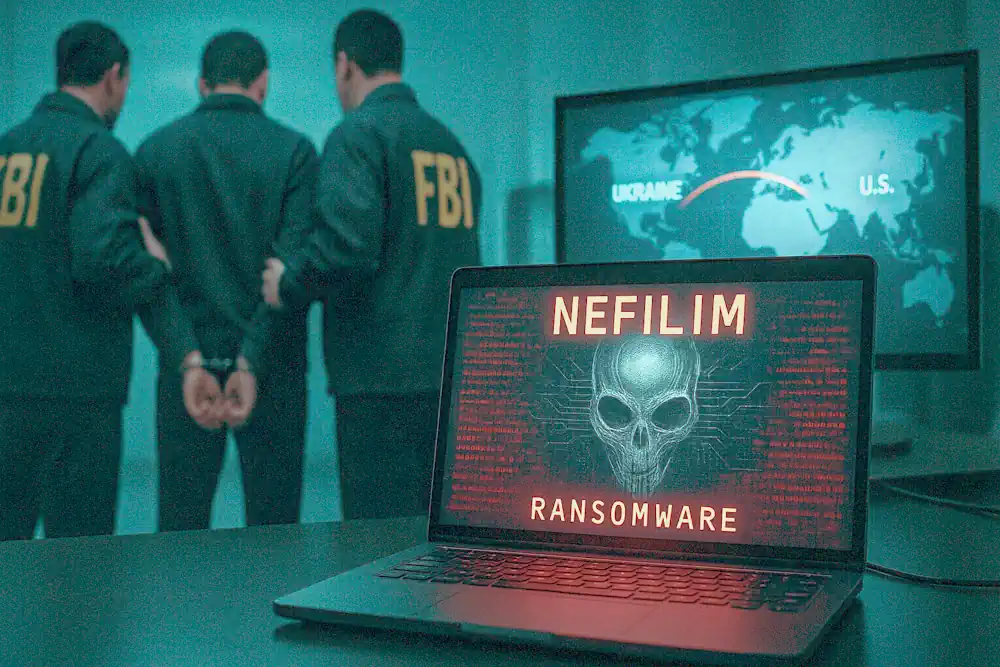In a significant development for American cybersecurity enforcement, a Ukrainian national has been extradited from Spain to face federal charges related to a series of high-stakes ransomware attacks that primarily targeted U.S. corporations. The case highlights the growing international cooperation in combating cybercrime that has increasingly threatened American businesses and infrastructure, while raising questions about the adequacy of current defenses against such sophisticated digital extortion schemes.
Article Summary:
The Alleged Architect Behind Nefilim’s Corporate Targets
Artem Aleksandrovych Stryzhak, 35, was arrested in Spain in June 2024 and extradited to the United States on April 30, 2025. According to federal prosecutors, Stryzhak allegedly joined the Nefilim ransomware operation as an affiliate in June 2021, agreeing to a 20% commission structure on any ransom payments generated through his attacks.
The Justice Department alleges that Stryzhak and his co-conspirators methodically researched potential victims using online business intelligence platforms to identify high-value targets. These platforms provided crucial information about companies’ revenue figures, organizational size, and contact information, with ZoomInfo reportedly being a preferred research tool among ransomware operators targeting American businesses.
“In one exchange with Stryzhak in or about July 2021, a Nefilim administrator encouraged him to target companies in these countries with more than $200 million in annual revenue,” the Justice Department stated in its press release, revealing the calculated approach behind victim selection.
The Double Extortion Playbook
The Nefilim operation exemplifies the increasingly sophisticated “double extortion” tactics that have become standard among cybercriminal enterprises targeting American organizations. This approach involves not only encrypting victims’ systems but also exfiltrating sensitive data before encryption, creating two leverage points for payment: the need to restore operations and the threat of data exposure.
When conducting attacks, Nefilim affiliates would allegedly breach corporate networks, steal valuable data, and then deploy ransomware to encrypt devices across the organization. Victims would receive demands for payment in bitcoin in exchange for decryption keys and assurances that stolen data would not be published. If organizations refused to pay, attackers would follow through on threats to publish the exfiltrated information on specialized data leak sites frequented by competitors, journalists, and other cybercriminals.
This evolution in ransomware tactics has created particularly difficult risk calculations for American corporations, who must weigh the costs of business interruption against potential regulatory penalties and reputational damage from data breaches, all while federal agencies generally discourage ransom payments.
Rising Threats to Critical Infrastructure
The Nefilim ransomware first emerged in 2020, sharing significant code with the earlier Nemty ransomware variant. Security researchers noted its technical sophistication, including the use of AES-128 encryption and distinctive markers like the “.NEFILIM” file extension added to encrypted files. The operation left ransom notes titled “NEFILIM-DECRYPT.txt” throughout victims’ systems, establishing a seven-day deadline for negotiations before data publication would begin.
Cybersecurity analysts believe Nefilim later rebranded under multiple names including Fusion, Milihpen, Gangbang, Nemty, and Karma – a common tactic among ransomware groups to evade law enforcement attention and sanctions. This pattern of rebranding has complicated efforts by American authorities to track and disrupt these criminal enterprises.
Notable victims of Nefilim attacks included several multinational corporations with significant American operations, including Toll Group, Orange, and Whirlpool, demonstrating the group’s focus on large enterprises capable of paying substantial ransoms.
Federal Prosecution and International Cooperation
Stryzhak now faces charges of conspiracy to commit fraud and related activity, including extortion, in connection with computers. The indictment was unsealed in federal court in Brooklyn, where he is scheduled for arraignment before U.S. Magistrate Judge Robert M. Levy. If convicted, he faces a maximum sentence of five years in federal prison.
This case represents another example of increasing international cooperation in addressing cybercrime threats that transcend national borders. The successful extradition from Spain demonstrates how American law enforcement continues to extend its reach globally to prosecute individuals allegedly involved in cyberattacks against U.S. interests, even as critics question whether such prosecutions meaningfully deter the broader ransomware ecosystem.
As ransomware continues to pose a significant threat to American businesses, critical infrastructure, and government agencies, this case underscores both the progress made in international cybercrime enforcement and the ongoing challenges in preventing these increasingly sophisticated attacks before they cause harm to U.S. organizations and consumers.

